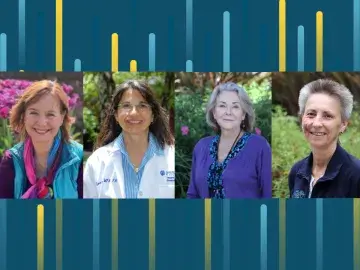Physical Therapy in a Virtual World

Shifting his weight from side to side like he’s ready to pounce, Huy Trinh, DPT ’21, signals the next move to half-a-dozen community members tuned in on Zoom for a physical therapy shadowboxing class.
“2!” Trinh calls out, throwing a right cross for participants who appear on his screen Brady Bunch-style. They are mostly in their 60s and 70s, and some are in their living rooms, a couple in their bedrooms, one is in his garage. Some are sitting, some standing, and some have caregivers by their sides.
More or less in unison, their right fists and arms cross their bodies and aim toward Trinh’s chin. He ducks, as if the punches are coming at him through the screen.
“You almost got me there, Karen,” Trinh, jokes and laughs. The participants smile.
Everyone returns to the “ready” position, standing with fists clenched and arms raised to protect themselves.
“5!” says Trinh, who is one of two Doctor of Physical Therapy program students teaching the free community class. His fists pop up to block the incoming left uppercuts from the Brady Bunch.
“Good, David,” says Nathaniel Markman, DPT ’21, the class’ second instructor, to one of the participants. “Don’t forget to keep your chests open and your backs nice and tall,” Markman says to the class.
The class is one of several that moved online last fall when face-to-face instruction shut down. All of SMU’s classes, clinicals, and labs, like this one, transitioned online to allow students to continue their physical therapy education and deliver much-needed support to community members.
“The pandemic is forever changing how our PT students will provide care during their careers, especially community education, and how often they have telehealth appointments,” says Assistant Professor Stephanie Greenspan. “Now, they’ve learned how to use virtual platforms like Zoom and WebEx effectively and creatively, and see the vast possibilities virtual care can offer.”
The virtual environment presented challenges, of course, especially early on, that required students to develop new and different approaches for assessing and working with community participants, who they’d normally be in the same room with. One method was for one student to lead the exercise while another monitored participants for safety and to identify and suggest adjustments to their technique and intensity. With practice, Trinh and Markman learned to keep the class moving with hand signals, like giving thumbs up or down, to get feedback from participants to minimize interruptions.
The six-week shadowboxing class was designed specifically to help people with Parkinson’s Disease build strength, balance, and endurance, which can help them optimize their movement as they face challenges with resting tremors, unstable posture that impairs balance, and rigidity in their muscles. Trinh and Markman tapped into techniques for the class that people with Parkinson’s are known to respond to, such as using short, loud verbal cues.
That’s where those numbers came in. Because people with Parkinson’s often have trouble multitasking, Trinh and Markman assign each boxing move a number to get participants thinking and give them a mental as well as a physical workout.
“The patients benefited in terms of upper body strength and improved endurance. They’d tell us they can feel their arms getting stronger and that they just had a really fun time,” Trinh says.
Mental health isn’t something many people associate with physical therapists, but it’s a focus of therapists’ education at SMU because patients see better outcomes when they are treated as a whole, rather than as a composite of symptoms.
“While our primary intent is often to address movement and physical function, if we can find ways to intervene that also benefit mental health needs, then we are doing a better job of addressing the whole person,” Greenspan says.
For their graduation research project, Alison Castaneda, DPT ’21, and Meghan Thompson, DPT ’21, wanted to study the effectiveness of dance therapy for trauma victims. They created Dance for Hope—a class that melded Castaneda’s lifelong love of dance and Thompson’s passion for promoting women’s health.
They partnered with Rising International, a Santa Cruz-based nonprofit that helps women survive extreme poverty, gender-based violence, homelessness, and human trafficking. The women, 26 to 64 years old, were all dealing with the long-term effects of trauma and PTSD. One, for example, was homeless and attended the classes from a different location each week—sometimes a parking lot, other times a friend’s backyard, or wherever she could find Wi-Fi.
The six-week dance class focused on health education, promoting mental and physical well-being, and creating a safe space for women to do self-care.
“We wanted to show the women that physical activity can be fun,” says Thompson. “More can be gained than just the physical outcomes of getting your body moving. There’s also mental and psychological benefits that can occur when you get your endorphins up and you’re surrounded by a community of people.”
To help drive that tenet home, Thompson and Castaneda’s slogan was, “All movement is good movement.” “It’s not about getting the steps perfect,” says Castaneda. “It’s about moving how your body wants to move, expressing yourself how you’d like to or how you feel.”
Several women in Dance for Hope, say it was an uplifting time for them. “Many of the women didn’t realize how much joy the dance class would bring, how good they would feel during the class, and how these feelings carried over into the rest of their week,” says Carmel Jud, Rising International’s founder and executive director. “Learning to dance took their minds off the challenges of the day.”
Shadowboxing and Dance for Hope are just two examples of SMU’s Pro Bono Experiences series that provides students the chance to practice their skills in lab settings with community members under faculty supervision. The group classes, eight of which were offered in the fall, focus on topics such as a fall prevention class for older community members, yoga for cancer survivors, and fitness for people living with multiple sclerosis and Parkinson’s Disease.
“We seek to recruit underserved members of our community for the Pro Bono Experiences classes,” says Greenspan. “And while ‘underserved,’ in general, means they have limited access to quality care, the barriers can vary.” Common impediments include a lack of health insurance, insurance with few options for providers in their geographic area, or few providers who have expertise on their medical condition, to name a few.
Whether the SMU students were shadowboxing or dancing, the lessons they learned while leading virtual group PT sessions are likely to stick with them long after the pandemic, Greenspan says.
“Since Dance for Hope, I’ve been using dance a lot with my patients,” Thompson says. “Often in physical therapy, we prescribe exercises. And a lot of the time, people don’t like exercises. But when we can structure exercises in an activity that they enjoy, they’re going to be more likely to do it and it will make them feel good.”
Trinh, who wants to work with patients with neurological disorders like strokes and Parkinson’s after he graduates, is grateful to have taught virtual shadowboxing. “I was able to have fun with it and explore my creativity in a safe environment. My professors gave me feedback to improve and the opportunities to make it my own.”
The virtual environment taught students, as well as faculty, to be more flexible, creative, and solve problems—skills that will help them professionally. The virtual classes also sent a message and set a standard for how valuable and important community care is, Greenspan says.
“As healthcare providers, we couldn’t just sit idly while it felt like the world shut down. What message does that send to the people we care for who depend on us and our students who still need to learn?” Greenspan says. “Doing these virtual labs with community participants during COVID was a powerful experience.”


